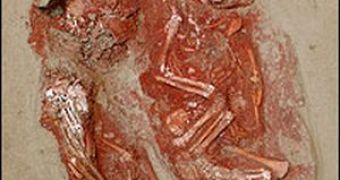Archaelogists have discovered the graves of three infants from Upper Paleolithic period (27,000 years old) in Austria, a first of its kind finding in Europe.
The skeletons, all embedded in ochre (a red pigment), were in two separate burial pits.
One pit unearthed in 2005 contained two bodies, that might be twins, disposed side by side, covered by a mammoth's shoulder blade supported by part of a tusk.
An incisor from one of the children points to a death age of nine or ten months.
A third infant, thought to have died at less than three months, was found in 2006 in a second pit 3 feet (1 m) away. "The twins had been protected from the elements by the mammoth bone and were very well preserved", says Christine Neugebauer-Maresch of the Prehistoric Commission of the Austrian Academy of Sciences in Vienna.
Previously, "there were no graves of newborns at all," Neugebauer-Maresch says.
"We think if there are two preserved it's possible there are much more."
The well-preserved remains were analyzed by laser scanning and computer imaging.
Some artifacts survived in the graves.
One of the twins had more than 30 ivory beads near the pelvis.
"The lone skeleton contained an ivory pin, which may have held shut a leather or fur wrapping", Neugebauer-Maresch said.
The remains were discovered in an 18-square-meter site in lower Austria, near the confluence between the river Krems and the Danube.
Artifacts from the site, including a fired piece of clay bearing a human fingerprint, belong to the Gravettian culture.
"The infant burials were similar to those for Gravettian adults, whose remains often include mammoth bones and jewelry," says anthropologist Olga Soffer of the University of Illinois at Urbana-Champaign.
"What is unusual is the extreme youth of these," she says.
"Dead kids are few and far between, and the younger you get the fewer there are."
The evidence from the site indicates that the infants belonged perhaps to important families of hunter-gatherer communities.
"The effort taken to bury and decorate the remains implies the infants or their families were held in high esteem," she notes.
Study of the physical traits of the children or eventually of DNA could help solving the puzzle over the inter breeding between humans and Neanderthals, highly incensed by fossils found in Romania and showing certain Neanderthal traits.
"It will always be a little problematic because the remains are not mature, but it will be an important point of reference," said Soffer.
Photo credit: Natural History Museum Vienna; Prehistoric Commission Austrian Academy of Sciences.

 14 DAY TRIAL //
14 DAY TRIAL // 
